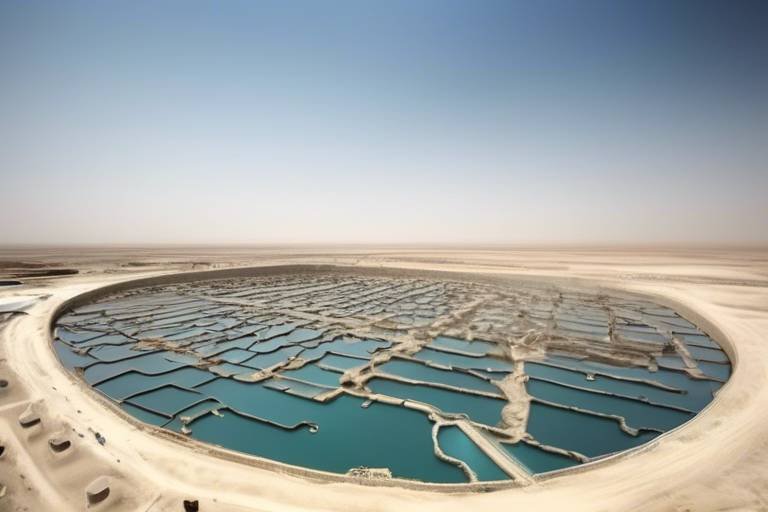The Benefits and Risks of Climate Geoengineering
Climate change is often likened to a ticking time bomb, and as its impacts become increasingly evident, the urgency to find solutions escalates. One of the most debated strategies in the fight against climate change is climate geoengineering. This term encompasses a variety of techniques aimed at manipulating the Earth's climate system to counteract global warming. While the potential benefits of these methods are enticing, they come with a host of risks and ethical considerations that cannot be ignored.
At its core, climate geoengineering seeks to address the symptoms of climate change rather than its root causes. Imagine trying to fix a leaky roof by simply painting over the stains; it may look better temporarily, but the underlying issue remains. Similarly, geoengineering techniques aim to provide quick fixes to the climate crisis, but they might also lead to unforeseen consequences. This duality—of offering hope while posing risks—makes geoengineering a contentious topic among scientists, policymakers, and the public alike.
On one hand, advocates argue that geoengineering could serve as a necessary tool to rapidly reduce global temperatures, enhance agricultural productivity, and mitigate extreme weather events. For instance, techniques such as carbon dioxide removal (CDR) can help lower atmospheric CO2 levels, while solar radiation management (SRM) can reflect sunlight away from Earth. However, these methods are not without challenges. The implementation of geoengineering technologies could disrupt ecosystems, alter precipitation patterns, and create new ethical dilemmas regarding human intervention in natural systems.
Moreover, the question of governance looms large. Who gets to decide when and how to deploy these technologies? Without a robust framework for international cooperation and public engagement, geoengineering initiatives could lead to conflicts and inequities on a global scale. It’s akin to giving a child a box of matches without supervision; the potential for mischief is high, and the consequences could be dire.
As we delve deeper into the various aspects of climate geoengineering, it’s crucial to weigh both the potential benefits and the associated risks. Understanding these facets will not only inform public discourse but also guide future research and policy decisions. In this article, we will explore the techniques of climate geoengineering, the possible advantages they offer, the risks they pose, and the ethical considerations that should shape their development.
- What is climate geoengineering? Climate geoengineering refers to a range of techniques aimed at deliberately altering the Earth's climate system to counteract the effects of climate change.
- What are the benefits of climate geoengineering? Potential benefits include rapid temperature reduction, enhanced agricultural productivity, and the mitigation of extreme weather events.
- What are the risks associated with climate geoengineering? Risks may include unforeseen environmental consequences, disruption of ecosystems, and complex governance challenges.
- Is climate geoengineering a long-term solution? Most experts believe that geoengineering should not be seen as a substitute for reducing greenhouse gas emissions but rather as a potential supplementary measure.

Understanding Climate Geoengineering
Climate geoengineering, often referred to as climate engineering, encompasses a range of innovative techniques aimed at deliberately manipulating the Earth’s climate system to counteract the adverse effects of global warming. At its core, it seeks to address the pressing issue of climate change through large-scale interventions. But what exactly does this mean? Well, think of it as a kind of "climate repair" toolkit where scientists and researchers explore various methods to stabilize or even reverse some of the damage caused by human activities.
There are two primary categories of climate geoengineering: Carbon Dioxide Removal (CDR) and Solar Radiation Management (SRM). CDR focuses on removing CO2 from the atmosphere, while SRM aims to reflect sunlight away from the Earth to reduce warming. Each approach has its unique methodologies, potential benefits, and risks. For instance, CDR techniques include afforestation, direct air capture, and ocean fertilization, all of which strive to lower atmospheric carbon levels. On the other hand, SRM methods such as stratospheric aerosol injection and marine cloud brightening attempt to cool the planet by altering how sunlight interacts with the atmosphere.
To better understand these concepts, let’s break down some of the key techniques involved in climate geoengineering:
| Technique | Description | Category |
|---|---|---|
| Afforestation | Planting trees to absorb CO2 from the atmosphere. | CDR |
| Direct Air Capture | Using technology to extract CO2 directly from the air. | CDR |
| Ocean Fertilization | Adding nutrients to the ocean to boost phytoplankton growth, which absorbs CO2. | CDR |
| Stratospheric Aerosol Injection | Injecting aerosols into the stratosphere to reflect sunlight. | SRM |
| Marine Cloud Brightening | Enhancing the reflectivity of clouds over oceans to cool the planet. | SRM |
The potential of climate geoengineering is both exciting and daunting. Imagine being able to cool the planet or absorb billions of tons of CO2 from the atmosphere! However, it’s crucial to approach these techniques with caution. The implications of altering our climate systems are profound, and the unintended consequences could be catastrophic. For instance, what happens if we reflect too much sunlight and inadvertently disrupt weather patterns? Or if we plant vast forests that consume water resources needed for agriculture? These are the questions that researchers grapple with as they explore the viability of geoengineering solutions.
In summary, climate geoengineering presents a fascinating yet complex landscape of possibilities and challenges. As we delve deeper into the potential benefits and risks, it becomes clear that this is not just a scientific endeavor but a moral and ethical one as well. The decisions we make today regarding these techniques could shape the future of our planet for generations to come.

Potential Benefits of Climate Geoengineering
Climate geoengineering presents a fascinating array of possibilities that could potentially revolutionize our approach to combating climate change. Imagine a world where we can rapidly reduce global temperatures, enhance agricultural productivity, and even mitigate extreme weather events—all through innovative technological interventions. The allure of these benefits is not just a pipe dream; they are grounded in research and experimentation.
One of the most significant advantages of climate geoengineering is its potential for rapid temperature reduction. As global temperatures continue to rise, the urgency to find immediate solutions becomes more pressing. Techniques like solar radiation management (SRM) could theoretically lower temperatures by reflecting sunlight away from the Earth. This could buy us critical time to transition to sustainable energy sources without the immediate threat of a climate crisis.
In addition to cooling the planet, geoengineering could also enhance agricultural productivity. With climate change wreaking havoc on traditional farming practices, innovative methods such as ocean fertilization could stimulate phytoplankton growth, which in turn absorbs carbon dioxide and produces oxygen. This not only helps in reducing atmospheric CO2 levels but also supports marine ecosystems, providing a dual benefit that could bolster food security.
Moreover, climate geoengineering holds the promise of mitigating extreme weather events. By addressing the root causes of climate change, such as greenhouse gas emissions, we could potentially lessen the frequency and intensity of hurricanes, droughts, and floods. For instance, stratospheric aerosol injection could reduce the severity of heatwaves, protecting vulnerable populations and ecosystems alike.
To give you a clearer picture, here’s a quick overview of some key benefits:
| Benefit | Description |
|---|---|
| Rapid Temperature Reduction | Techniques like solar radiation management could lower global temperatures quickly. |
| Enhanced Agricultural Productivity | Methods such as ocean fertilization could stimulate growth in marine ecosystems and improve food security. |
| Mitigation of Extreme Weather | Geoengineering could reduce the frequency and intensity of natural disasters. |
However, while the potential benefits are compelling, it is crucial to approach climate geoengineering with caution. The prospect of manipulating the Earth’s climate system raises numerous ethical considerations and risks that must be carefully evaluated. As we delve deeper into this topic, it’s essential to balance optimism with responsibility, ensuring that any actions taken are in the best interest of our planet and future generations.
In summary, the potential benefits of climate geoengineering are vast and varied. From cooling our planet to securing food sources and mitigating extreme weather, these techniques offer a glimmer of hope in the fight against climate change. Yet, as we explore these avenues, we must remain vigilant, weighing the pros against the cons to navigate this complex landscape responsibly.
- What is climate geoengineering? Climate geoengineering refers to deliberate large-scale interventions in the Earth’s climate system to counteract climate change.
- What are the main techniques used in climate geoengineering? The two main categories are carbon dioxide removal (CDR) techniques and solar radiation management (SRM) strategies.
- Are there any risks associated with climate geoengineering? Yes, risks include unforeseen environmental impacts, governance challenges, and ethical dilemmas regarding intervention in natural systems.
- How can climate geoengineering help agriculture? By enhancing conditions for growth and mitigating climate-related disruptions, geoengineering can potentially boost agricultural productivity.

Carbon Dioxide Removal Techniques
Carbon dioxide removal (CDR) techniques are at the forefront of the fight against climate change. These methods aim to actively reduce the amount of CO2 in the atmosphere, addressing one of the primary drivers of global warming. With rising CO2 levels contributing to severe weather patterns, melting ice caps, and rising sea levels, the urgency for effective CDR solutions has never been greater. But what exactly are these techniques, and how do they work?
Among the various CDR methods, three prominent strategies stand out: afforestation, direct air capture, and ocean fertilization. Each of these approaches has unique mechanisms, benefits, and challenges, making them essential components of a comprehensive climate strategy.
Afforestation involves planting trees in areas that have not been forested for a long time, while reforestation refers to restoring forests that have been depleted. Trees are natural carbon sinks, absorbing CO2 as they grow. This method not only helps in sequestering carbon but also enhances biodiversity, improves air quality, and supports local ecosystems. However, challenges such as land availability, water resources, and the potential for invasive species must be carefully managed to ensure successful implementation.
Direct air capture (DAC) technology is a game-changer in the realm of CDR. This innovative approach utilizes chemical processes to extract CO2 directly from the atmosphere. Once captured, the CO2 can be stored underground or utilized in various industrial processes. The scalability of DAC is promising, but it comes with economic implications. The costs of building and operating DAC facilities can be high, leading to debates over its feasibility compared to other methods. Nonetheless, as technology advances, the hope is that DAC will become more accessible and cost-effective.
Another intriguing technique is ocean fertilization, which involves adding nutrients to ocean waters to stimulate the growth of phytoplankton. These microscopic plants absorb CO2 during photosynthesis, effectively pulling carbon from the atmosphere. While this method has the potential to sequester significant amounts of CO2, it raises concerns about the ecological impacts on marine ecosystems and the risk of harmful algal blooms. Therefore, careful research and monitoring are essential before large-scale implementation.
In summary, carbon dioxide removal techniques present a multifaceted approach to tackling climate change. Each method offers distinct advantages and challenges, emphasizing the importance of a diversified strategy in our efforts to combat global warming. As we delve deeper into the complexities of these techniques, it becomes clear that innovation and responsible management will be crucial in shaping their future.
- What is carbon dioxide removal? Carbon dioxide removal refers to various techniques aimed at reducing CO2 levels in the atmosphere to combat climate change.
- How effective are these techniques? The effectiveness varies by method; afforestation can sequester large amounts of CO2, while direct air capture is still being optimized for scalability and cost.
- What are the risks associated with these methods? Risks include potential ecological impacts, economic viability, and the need for careful governance and regulation.

Afforestation and Reforestation
Afforestation and reforestation are two powerful strategies in the fight against climate change, often viewed as nature's own way of addressing the carbon crisis. But what do these terms really mean? Afforestation refers to the process of planting trees in areas that have not been previously forested, while reforestation involves restoring trees to areas that have been deforested. Both practices not only sequester carbon dioxide from the atmosphere but also enhance biodiversity and improve soil quality. Imagine a barren land transforming into a lush forest teeming with life—this is the magic of planting trees!
One of the key benefits of afforestation and reforestation is their ability to capture and store carbon. Trees act like natural sponges, absorbing CO2 during photosynthesis. According to recent studies, a mature tree can absorb about 48 pounds (approximately 22 kilograms) of CO2 per year. This means that large-scale tree planting can significantly contribute to reducing atmospheric CO2 levels. In fact, a global initiative to plant one trillion trees has been proposed as a viable solution to combat climate change, showcasing the immense potential of these practices.
However, implementing these strategies is not without its challenges. Land use is a significant concern, as finding suitable areas for afforestation can lead to competition with agricultural land, potentially threatening food security. Furthermore, the success of these initiatives depends on the selection of appropriate tree species that are native to the area, ensuring that they can thrive and support local ecosystems. Careful planning and community involvement are crucial to overcoming these hurdles. After all, a tree planted without consideration for its environment may not survive, and we wouldn't want to waste our efforts!
Moreover, afforestation and reforestation can provide a plethora of additional environmental benefits. They enhance biodiversity by creating habitats for various species, improve air quality, and help regulate water cycles. For instance, forests play a crucial role in maintaining the water cycle by promoting rainfall and reducing soil erosion. This multifaceted approach to environmental restoration is essential for creating resilient ecosystems that can withstand the impacts of climate change.
To summarize, afforestation and reforestation are not just about planting trees; they are about creating a sustainable future. By sequestering carbon, enhancing biodiversity, and providing a wealth of ecological benefits, these strategies hold immense potential. Yet, as we embark on this green journey, we must remain mindful of the challenges and ethical considerations involved in implementing such initiatives. After all, every tree planted is a step toward a healthier planet, but it must be done thoughtfully and responsibly.
- What is the difference between afforestation and reforestation? Afforestation involves planting trees in areas that were not previously forested, while reforestation focuses on restoring trees in areas that have been deforested.
- How much carbon can a single tree absorb? A mature tree can absorb about 48 pounds (approximately 22 kilograms) of CO2 each year.
- What are the main challenges of afforestation? Challenges include land use competition, choosing appropriate native species, and ensuring community involvement.

Direct Air Capture
Direct Air Capture (DAC) is an innovative technology designed to remove carbon dioxide (CO2) directly from the atmosphere. Imagine a giant vacuum cleaner, but instead of cleaning your living room, it's sucking up the very gas that's contributing to climate change. This method holds promise in the fight against global warming, and it’s gaining traction as a viable solution to combat the rising levels of greenhouse gases. The technology works by utilizing chemical processes to capture CO2 molecules from the air, which can then be stored underground or repurposed for various uses, such as creating synthetic fuels or enhancing agricultural growth.
There are several approaches to DAC, but the most common involves two main steps: capture and storage. During the capture phase, air is drawn into a system that contains special filters or chemicals that bind with CO2. Once captured, the CO2 can be released from the filters through a process that often requires heat or pressure. The stored CO2 can then be either sequestered underground in geological formations or utilized in industrial applications. This dual functionality makes DAC not just a carbon removal solution, but also a potential player in creating a circular economy.
One of the most significant advantages of DAC is its scalability. Unlike afforestation, which requires large amounts of land and time to grow trees, DAC facilities can be built in urban areas where space is limited. This opens up opportunities for cities to actively participate in carbon reduction efforts. However, scaling up DAC technology comes with its own set of challenges. The energy required to operate DAC systems can be substantial, raising questions about the source of that energy. Ideally, it should come from renewable sources to ensure that the carbon footprint of the DAC process is minimized.
Moreover, the economic implications of DAC are significant. Initial investments in DAC technology can be high, but as technology advances and becomes more widespread, costs are expected to decrease. A recent study indicated that the price of capturing CO2 could drop significantly over the next decade, making it more accessible for widespread adoption. To illustrate this point, consider the following table summarizing the estimated costs of various carbon capture methods:
| Method | Estimated Cost per Ton of CO2 Captured |
|---|---|
| Direct Air Capture | $100 - $600 |
| Post-Combustion Capture | $50 - $100 |
| Pre-Combustion Capture | $30 - $80 |
While DAC presents a compelling solution to reducing atmospheric CO2 levels, it’s essential to consider the broader context of climate change mitigation. It should not be viewed as a standalone solution but rather as part of a comprehensive strategy that includes reducing emissions at their source, enhancing energy efficiency, and transitioning to renewable energy sources. As we navigate the complexities of climate action, DAC can be a critical tool in our arsenal, helping to bridge the gap while we work towards a more sustainable future.
- What is Direct Air Capture?
Direct Air Capture is a technology that removes carbon dioxide from the atmosphere using chemical processes.
- How does Direct Air Capture work?
It captures air, filters out CO2, and can either store it underground or use it for other applications.
- What are the costs associated with Direct Air Capture?
The estimated costs can range from $100 to $600 per ton of CO2 captured, depending on the technology and scale.
- Is Direct Air Capture the only solution to climate change?
No, it should be part of a broader strategy that includes reducing emissions and transitioning to renewable energy.

Solar Radiation Management Techniques
When it comes to tackling the daunting challenge of climate change, one of the most intriguing avenues is solar radiation management (SRM). This approach encompasses a variety of techniques aimed at reflecting a portion of the sun's energy back into space, thereby reducing the amount of heat absorbed by the Earth. Think of it as putting on a pair of sunglasses to shield our planet from the harsh rays of the sun. While the concept sounds promising, it's essential to delve deeper into the specific methods and their potential implications.
One of the most discussed techniques is stratospheric aerosol injection. This method involves injecting tiny particles—such as sulfur dioxide—into the stratosphere to create a reflective layer that can scatter sunlight. Imagine a giant umbrella shielding us from the sun's intense glare. Research suggests that this technique could potentially lower global temperatures significantly. However, the potential for unintended consequences, such as altering precipitation patterns or damaging the ozone layer, raises serious concerns.
Another innovative technique is marine cloud brightening. This method aims to enhance the reflectivity of clouds over the oceans by spraying fine sea water droplets into the atmosphere. These droplets can increase cloud albedo, making them more effective at reflecting sunlight. Picture a natural air conditioner that cools the Earth, but with the risk of changing local weather systems and marine ecosystems. While the concept is intriguing, the ecological ramifications could be profound.
In addition to these methods, there are several other SRM strategies being explored, including surface albedo modification, which involves increasing the reflectivity of land surfaces (like painting roofs white or using reflective materials in urban design). This technique could be implemented relatively quickly and at a lower cost compared to other methods. However, the challenge lies in ensuring that these modifications do not disrupt local climates or ecosystems.
While the potential benefits of solar radiation management are compelling, they are not without their risks. As we navigate this uncharted territory, it is crucial to consider the ethical implications and governance issues associated with such interventions. The question arises: who gets to decide when and how these techniques are deployed? The global nature of climate change necessitates international cooperation and regulatory frameworks to manage the risks effectively.
In conclusion, solar radiation management techniques present a fascinating yet complex solution to combat climate change. As we continue to explore these methods, we must balance the potential for rapid climate intervention with the need for careful consideration of environmental impacts and ethical concerns. The journey toward a sustainable future is undoubtedly filled with challenges, but understanding and addressing these techniques is a vital step in the right direction.
- What is solar radiation management? Solar radiation management refers to a set of techniques aimed at reflecting sunlight away from the Earth to reduce global warming.
- How does stratospheric aerosol injection work? This method involves injecting reflective particles into the stratosphere to scatter sunlight and cool the planet.
- What are the risks associated with solar radiation management? Potential risks include unintended environmental consequences, changes in weather patterns, and ethical dilemmas related to geoengineering interventions.
- Is solar radiation management a long-term solution for climate change? While it may provide temporary relief from warming, it is not a substitute for reducing greenhouse gas emissions.

Risks and Ethical Considerations
When diving into the intriguing world of climate geoengineering, it's essential to address the risks and ethical considerations that accompany this controversial approach. While the potential benefits are enticing, the implications of manipulating our planet's climate system can lead to unforeseen consequences that we must carefully evaluate. Imagine a world where we can control the weather, but at what cost? This dilemma raises critical questions about our responsibility towards nature and future generations.
One of the primary concerns surrounding climate geoengineering is the potential for environmental risks. For instance, altering weather patterns through techniques like solar radiation management could disrupt ecosystems in ways we can't predict. A single change in the atmosphere may lead to a ripple effect, impacting everything from rainfall distribution to marine life. Consider the hypothetical scenario where a sudden increase in stratospheric aerosols leads to decreased rainfall in one region, while another experiences flooding. Such disparities could exacerbate existing inequalities and create new conflicts over resources.
Moreover, the governance and regulation of geoengineering initiatives present a significant challenge. Who gets to decide when and how to implement these technologies? The lack of a comprehensive international framework raises concerns about accountability and transparency. In a world where climate change knows no borders, cooperation among nations is vital. However, the complexities of international politics often hinder effective collaboration. Imagine a situation where one country decides to deploy a geoengineering technique without the consent or knowledge of others; the consequences could be catastrophic.
Ethically, we must ask ourselves, "Is it right to intervene in natural systems?" This question leads us to ponder the moral implications of geoengineering. Some argue that we have a duty to protect our planet and its inhabitants, while others caution against playing God. The precautionary principle suggests that we should avoid actions that could cause irreversible harm, especially when the long-term effects are unknown. Balancing the urgency of climate action with ethical considerations is a tightrope walk that requires careful deliberation.
To further illustrate the complexities of these risks and ethical dilemmas, let's look at a comparison of some geoengineering methods and their associated concerns:
| Geoengineering Method | Potential Risks | Ethical Considerations |
|---|---|---|
| Solar Radiation Management | Disruption of weather patterns, unintended consequences on ecosystems | Intervention in natural processes, potential for unequal impacts |
| Carbon Dioxide Removal | Land use conflicts, biodiversity loss | Responsibility towards future generations, equity in access |
| Ocean Fertilization | Algal blooms, marine ecosystem disruption | Long-term ecological impacts, consent from affected communities |
As we explore the future of climate geoengineering, it becomes increasingly clear that addressing these risks and ethical considerations is crucial. We must engage in open dialogues, involving scientists, policymakers, and the public to navigate these complex waters. After all, the decisions we make today will shape the world we leave behind for future generations. Are we ready to take on this responsibility?
- What is climate geoengineering? Climate geoengineering refers to deliberate interventions aimed at altering the Earth's climate system to mitigate the effects of climate change.
- What are the main risks associated with geoengineering? Risks include environmental disruptions, governance challenges, and ethical dilemmas regarding intervention in natural systems.
- How can we ensure responsible governance of geoengineering initiatives? Establishing international frameworks, promoting transparency, and involving public engagement in decision-making are essential steps.
- Are there any ethical concerns related to climate geoengineering? Yes, ethical concerns revolve around the potential for unequal impacts, responsibility towards future generations, and the moral implications of intervening in nature.

Environmental Risks
When we think about climate geoengineering, it’s easy to get caught up in the excitement of potential solutions to our planet’s warming crisis. However, we must also face the that accompany these bold interventions. Imagine trying to fix a leaky roof by throwing a tarp over it; while it may stop the rain for a moment, it could also lead to mold and further damage. Similarly, the techniques aimed at cooling the Earth or removing carbon from the atmosphere can have unintended consequences that might disrupt existing ecosystems.
One of the primary concerns is the potential for ecosystem disruption. For instance, if we were to implement solar radiation management strategies, such as stratospheric aerosol injection, we could inadvertently alter weather patterns. This alteration could lead to shifts in rainfall distribution, affecting agriculture and water supply in various regions. A study by the National Academy of Sciences highlighted that such geoengineering efforts could cause a significant decrease in precipitation in some areas while increasing it in others, leading to a ripple effect of droughts and floods.
Moreover, we should consider the changes in precipitation patterns that could arise from geoengineering. The introduction of large-scale interventions might create winners and losers in terms of climate stability. For example, while some regions might enjoy a temporary cooling effect, others could experience extreme weather events, such as hurricanes or heatwaves. The unpredictability of these outcomes raises a red flag for scientists and policymakers alike. It’s like a game of chess where one wrong move could lead to a checkmate for entire ecosystems.
Another critical aspect to examine is the potential for unintended consequences. The very nature of geoengineering is to intervene in complex natural systems that have evolved over millennia. The introduction of new materials or techniques could lead to unforeseen interactions within the environment. For instance, ocean fertilization, which aims to stimulate phytoplankton growth to absorb CO2, could disrupt marine food chains and lead to algal blooms that produce toxins harmful to marine life and humans alike.
To better understand these risks, we can categorize them into several key areas:
- Disruption of Biodiversity: Altering ecosystems can lead to the decline of certain species while promoting the growth of others, thereby disrupting the delicate balance of nature.
- Feedback Loops: Some geoengineering methods might trigger feedback loops that exacerbate climate change instead of mitigating it. For example, reflecting sunlight away from Earth could lead to a cooling effect that might cause ice sheets to stabilize, only to have them melt rapidly later due to other warming influences.
- Long-Term Consequences: The long-term effects of geoengineering techniques are largely unknown. What seems beneficial today might have disastrous repercussions in the future, akin to taking a medication without understanding its side effects.
In summary, while climate geoengineering holds promise for addressing the urgent challenges posed by climate change, we must tread carefully. The environmental risks associated with these techniques are significant and warrant thorough research and consideration. It’s crucial that we weigh the potential benefits against the possible harms, ensuring that our solutions do not become new problems.
Q1: What is climate geoengineering?
A1: Climate geoengineering refers to deliberate interventions in the Earth’s climate system to counteract the effects of climate change, such as global warming.
Q2: What are some examples of geoengineering techniques?
A2: Examples include carbon dioxide removal methods like afforestation and direct air capture, as well as solar radiation management techniques like stratospheric aerosol injection.
Q3: What are the main environmental risks associated with geoengineering?
A3: Key risks include ecosystem disruption, changes in precipitation patterns, unintended consequences affecting biodiversity, and the possibility of creating feedback loops that worsen climate change.
Q4: Why is governance important in geoengineering?
A4: Governance is crucial because it ensures that geoengineering initiatives are regulated, ethical, and consider public opinion, mitigating risks associated with unilateral decision-making.

Governance and Regulation Challenges
When it comes to climate geoengineering, the phrase "with great power comes great responsibility" couldn't be more relevant. The ability to manipulate the climate system raises profound that we simply can't ignore. Who gets to decide when and how to deploy these controversial technologies? And what happens when different countries have conflicting interests? These questions highlight the complexities of governing geoengineering initiatives.
One of the biggest hurdles is the lack of a global regulatory framework. Currently, international laws surrounding climate intervention are sparse, leaving much room for interpretation. Without a unified approach, individual nations may pursue geoengineering projects that could have far-reaching effects on the global climate, potentially leading to conflicts and inequities. Imagine a scenario where one country employs a solar radiation management technique that inadvertently disrupts rainfall patterns in another country. The potential for diplomatic fallout is enormous.
Moreover, the ethical implications of geoengineering must be scrutinized. Are we, as a global community, ready to intervene in natural systems that have evolved over millions of years? The moral dilemmas surrounding geoengineering are as complex as the science itself. For instance, some argue that geoengineering could be seen as a "quick fix" that distracts from the need for comprehensive climate action, like reducing greenhouse gas emissions. This raises the question: are we willing to gamble with the planet's future for the sake of immediate relief?
Another aspect of governance challenges is the need for public engagement. Many geoengineering techniques are still in experimental stages, and the public's voice must be included in decision-making processes. Engaging with local communities, scientists, and policymakers can help build trust and ensure that diverse perspectives are considered. This is where transparency comes into play. The more transparent the processes, the more likely it is that the public will support or at least understand the decisions being made.
To provide a clearer picture of the governance challenges, consider the following table that outlines key issues and potential solutions:
| Governance Challenge | Potential Solutions |
|---|---|
| Lack of International Regulation | Develop a global treaty specifically for geoengineering. |
| Ethical Dilemmas | Establish ethical guidelines and review boards for geoengineering projects. |
| Public Trust and Engagement | Implement transparent communication strategies and public forums. |
| Disparate National Interests | Encourage international collaboration and joint research initiatives. |
In conclusion, the road to effective governance of climate geoengineering is fraught with challenges, but it is also an opportunity for innovation in policy-making. As we navigate this uncharted territory, we must prioritize cooperation, transparency, and ethical considerations. Only then can we hope to harness the potential benefits of geoengineering while minimizing its risks.
- What is climate geoengineering? Climate geoengineering refers to a set of techniques aimed at deliberately altering the Earth's climate system to counteract the effects of climate change.
- What are the main types of geoengineering? The main types include carbon dioxide removal (CDR) and solar radiation management (SRM).
- Why is governance important in geoengineering? Governance is crucial to ensure that geoengineering projects are conducted responsibly, ethically, and with consideration of global impacts.
- What are the risks associated with climate geoengineering? Risks include unforeseen environmental consequences, disruption of ecosystems, and moral dilemmas regarding intervention in natural systems.

Future of Climate Geoengineering
As we stand at the crossroads of innovation and environmental necessity, the is both a beacon of hope and a source of profound concern. With the urgency of climate change becoming increasingly evident, the need for effective solutions has never been more pressing. Researchers and scientists are diving deep into the potential of geoengineering to not only mitigate the impacts of global warming but also to reshape our approach to environmental stewardship. But what does the future hold? Are we ready to embrace these bold strategies, or will we shy away from the moral and ethical implications they bring?
Ongoing research is crucial in determining the viability and safety of various geoengineering techniques. Many experts believe that a combination of technological innovation and public engagement will pave the way for responsible implementation. For instance, advancements in carbon capture technologies and solar radiation management are already being explored in laboratories and pilot projects around the world. These technologies are not just theoretical; they are being tested in real-world scenarios to evaluate their effectiveness and scalability.
Public perception plays a significant role in the future of climate geoengineering. As awareness grows, so does the demand for transparency and ethical considerations. People want to know: How will these technologies affect our planet? Who will govern them? What are the potential risks? Addressing these questions is essential for fostering trust and acceptance among communities that might be directly impacted by geoengineering initiatives. Moreover, engaging the public in discussions about these technologies can lead to more informed decisions and inclusive policy-making.
In addition to public engagement, the role of international cooperation cannot be overstated. Climate change is a global issue that transcends borders, and so too must our solutions. Collaborative efforts among nations can facilitate the sharing of knowledge, resources, and best practices. This cooperation is vital not only for developing effective geoengineering strategies but also for establishing regulatory frameworks that ensure these technologies are used responsibly.
Looking ahead, the future of climate geoengineering is likely to be shaped by a combination of technological advancements, ethical considerations, and public discourse. As we navigate this complex landscape, it is crucial to balance the potential benefits with the inherent risks. The success of geoengineering initiatives will depend on our ability to innovate responsibly, engage the public, and cooperate internationally. Only then can we hope to harness the power of geoengineering to create a sustainable future for our planet.
- What is climate geoengineering? Climate geoengineering refers to deliberate large-scale interventions in the Earth's natural systems to combat climate change and its impacts.
- What are the main types of climate geoengineering? The two primary categories are carbon dioxide removal techniques and solar radiation management strategies.
- Are there risks associated with climate geoengineering? Yes, potential risks include unforeseen environmental consequences, disruption of ecosystems, and ethical dilemmas regarding intervention in natural systems.
- How can the public get involved in discussions about geoengineering? Public engagement can occur through community forums, educational programs, and participation in policy-making processes.
- What is the role of international cooperation in climate geoengineering? International cooperation is essential for sharing knowledge, resources, and creating regulatory frameworks to ensure responsible use of geoengineering technologies.
Frequently Asked Questions
-
What is climate geoengineering?
Climate geoengineering refers to a set of techniques aimed at deliberately altering the Earth's climate system to counteract the effects of climate change. This can include methods like carbon dioxide removal and solar radiation management. Think of it as a high-tech way to tweak our planet's thermostat!
-
What are the potential benefits of climate geoengineering?
There are several potential benefits, including rapid temperature reduction, improved agricultural productivity, and the ability to mitigate extreme weather events. Imagine being able to cool down the planet or boost crop yields just when we need it most!
-
How does carbon dioxide removal work?
Carbon dioxide removal (CDR) techniques, such as afforestation, direct air capture, and ocean fertilization, aim to extract CO2 from the atmosphere. It's like putting a giant vacuum cleaner to work on our air to help reduce greenhouse gases!
-
What are the risks associated with climate geoengineering?
While geoengineering holds promise, it also comes with risks, such as unforeseen environmental consequences, disruption of ecosystems, and changes in weather patterns. It's a bit like playing with fire; you have to be careful not to get burned!
-
How can we govern climate geoengineering initiatives?
Governance challenges include the need for international cooperation, regulatory frameworks, and public engagement. It’s essential to have a clear set of rules and involve the public in discussions, much like how we manage a community project together!
-
What is the future of climate geoengineering?
The future looks promising with ongoing research and technological advancements. Public perception and ethical considerations will play crucial roles in shaping how these techniques are developed and deployed. It's an evolving field, much like the tech industry, where innovation is key!



















